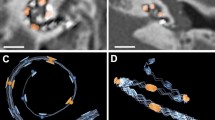Abstract
To evaluate and compare the effect of intra-scalar methylprednisolone and sodium hyaluronate on cochlear implants’ impedance and electrically evoked compound action potentials thresholds. In a prospective randomized clinical trial, 103 children with pre-lingual hearing loss candidates for cochlear implantation at a tertiary hospital were divided into three groups based on intervention. Intraoperatively, one group received intra-scalar methylprednisolone, the second sodium hyaluronate, and the third group was the control group. Impedance and electrically evoked compound action potentials (e-ECAP) thresholds on long-term follow-up were evaluated and compared in these three groups. Significant decrease in impedance and e-ECAP thresholds were observed in all groups in a 4-year follow-up. No statistically significant difference was observed among all mentioned groups. Impedance and e-ECAP thresholds decrease in the long term, and using topical intra-scalar Healon or methylprednisolone may not significantly affect these parameters.
Similar content being viewed by others
References
Morton NE (1991) Genetic epidemiology of hearing impairment. Ann N Y Acad Sci 630:16–31. https://doi.org/10.1111/j.1749-6632.1991.tb19572.x
Campbell VA, Crews JE, Moriarty DG et al (1999) Surveillance for sensory impairment, activity limitation, and health-related quality of life among older adults–United States, 1993–1997. MMWR CDC Surveill Summ Morb Mortal Wkly report. CDC Surveill Summ 48:131–156
Wackym P, Hirce k, Bernknopf H, Francis H (2021) Cochlear implantation: patient evaluation and device selection, in Flint PW, Francis HW, Haughey BH, Cummings otolaryngology–head & neck surgery. In: Cummings otolaryngology–head & neck surgery, Seventh Edit. Saunders, Philadelphia, PA, pp 2413–2424
Budenz CL, Pfingst BE, Raphael Y (2012) The use of neurotrophin therapy in the inner ear to augment cochlear implantation outcomes. Anat Rec (Hoboken) 295:1896–1908. https://doi.org/10.1002/ar.22586
Paasche G, Bockel F, Tasche C et al (2006) Changes of postoperative impedances in cochlear implant patients: the short-term effects of modified electrode surfaces and intracochlear corticosteroids. Otol Neurotol Off Publ Am Otol Soc Am Neurotol Soc [and] Eur Acad Otol Neurotol 27:639–647. https://doi.org/10.1097/01.mao.0000227662.88840.61
Hughes M (2012) Objective measures in Cochlear Implants. Plural Publishing, Incorporated
Nadol JB, Eddington DK (2006) Histopathology of the inner ear relevant to cochlear implantation. Adv Otorhinolaryngol 64:31–49. https://doi.org/10.1159/000094643
Kontorinis G, Paasche G, Lenarz T, Stöver T (2011) The effect of different lubricants on cochlear implant electrode insertion forces. Otol Neurotol 32(7):1050–6
Roland JTJ, Magardino TM, Go JT, Hillman DE (1995) Effects of glycerin, hyaluronic acid, and hydroxypropyl methylcellulose on the spiral ganglion of the guinea pig cochlea. Ann Otol Rhinol Laryngol Suppl 166:64–68
de Sauvage R, da Costa D, Erre JP, Aran JM (1997) Electrical and physiological changes during short-term and chronic electrical stimulation of the normal cochlea. Hear Res 110:119–134. https://doi.org/10.1016/s0378-5955(97)00066-x
Wilk M, Hessler R, Mugridge K et al (2016) Impedance changes and fibrous tissue growth after Cochlear Implantation are correlated and can be reduced using a Dexamethasone Eluting Electrode. PLoS ONE 11:e0147552. https://doi.org/10.1371/journal.pone.0147552
De Ceulaer G, Johnson S, Yperman M, Daemers K, Offeciers FE, O’Donoghue GM, Govaerts PJ (2003) Long-term evaluation of the effect of intracochlear steroid deposition on electrode impedance in cochlear implant patients. Otol Neurotol. 24(5):769–74
Huang CQ, Tykocinski M, Stathopoulos D, Cowan R (2007) Effects of steroids and lubricants on electrical impedance and tissue response following cochlear implantation. Cochlear Implants Int 8:123–147. https://doi.org/10.1179/cim.2007.8.3.123
Ahmadi N, Gausterer JC, Honeder C et al (2019) Long-term effects and potential limits of intratympanic dexamethasone-loaded hydrogels combined with dexamethasone-eluting cochlear electrodes in a low-insertion trauma Guinea pig model. Hear Res 384:107825. https://doi.org/10.1016/j.heares.2019.107825
Molisz A, Zarowski A, Vermeiren A et al (2015) Postimplantation changes of electrophysiological parameters in patients with cochlear implants. Audiol Neurootol 20:222–228. https://doi.org/10.1159/000377615
Botros A, van Dijk B, Killian M (2007) AutoNR: an automated system that measures ECAP thresholds with the Nucleus Freedom cochlear implant via machine intelligence. Artif Intell Med 40:15–28. https://doi.org/10.1016/j.artmed.2006.06.003
Telmesani LM, Said NM (2016) Electrically evoked compound action potential (ECAP) in cochlear implant children: changes in auditory nerve response in first year of cochlear implant use. Int J Pediatr Otorhinolaryngol 82:28–33. https://doi.org/10.1016/j.ijporl.2015.12.027
Brown CJ, Abbas PJ, Etlert CP, O’Brient S, Oleson JJ (2010) Effects of long-term use of a cochlear implant on the electrically evoked compound action potential. J Am Acad Audiol. https://doi.org/10.3766/jaaa.21.1.2
Funding
No funding was received for conducting this study.
Author information
Authors and Affiliations
Corresponding author
Ethics declarations
Conflict of interest
The authors declare that they have no conflicts of interest. The authors have no relevant financial or non-financial interests to disclose.
Ethical Approval
This study was approved by the Human Research Ethics committee of our institution (IR.SBMU.RETECH.REC.1400.860). The procedures used in this study adhere to the tenets of the Declaration of Helsinki.
Informed Consent
All patients had given informed consent.
Additional information
Publisher’s Note
Springer Nature remains neutral with regard to jurisdictional claims in published maps and institutional affiliations.
Rights and permissions
Springer Nature or its licensor (e.g. a society or other partner) holds exclusive rights to this article under a publishing agreement with the author(s) or other rightsholder(s); author self-archiving of the accepted manuscript version of this article is solely governed by the terms of such publishing agreement and applicable law.
About this article
Cite this article
Eftekharian, A., Khajavi, M., Moghadam, S. et al. Comparison Between the Effect of Intra-Scalar Methylprednisolone and Sodium Hyaluronate in Impedance and Electrically Evoked Compound Action Potentials in Cochlear Implant Patients. Indian J Otolaryngol Head Neck Surg 75 (Suppl 1), 285–290 (2023). https://doi.org/10.1007/s12070-022-03429-y
Received:
Accepted:
Published:
Issue Date:
DOI: https://doi.org/10.1007/s12070-022-03429-y




